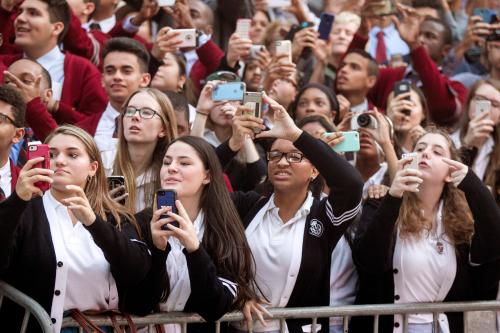Much has been written about millennials’ attraction to cities, adding to their social and economic vitality, and, in many cases, their revitalization. It should also be noticed that, as part of this, millennials have contributed substantially to the race and ethnic diversity of cities. As underscored in my report, “The millennial generation: A demographic bridge to America’s diverse future,” at 44 percent minority, millennials are the most diverse adult generation in American history.
Urban and suburban counties
Millennial diversity is especially evident in the core areas of America’s largest metropolitan areas (see Figure 1).

That is, nearly three-fifths of millennials residing in core urban counties are racial minorities, where more than a quarter are Hispanic, 18 percent are black, and the rest other races. Mature, largely inner-suburb millennials are only slightly less white—52 percent—than the national millennial population. But in emerging suburbs and exurbs, whites are far more prevalent at 62 percent and 72 percent, respectively. Suburban categories get less diverse as distance from the core increases. [i]
Perhaps even more significant are the contributions of racial minorities to the growth of the millennial-aged 18-34 year-old population. While white millennial gentrification is often cited as a source of youthful urban change, racial minorities were clearly major drivers of young adult growth in all urban and suburban categories in the first half of the decade.

Young adult urban core populations increased by 4.9 percent over this period, and racial minorities contributed the lion’s share—87 percent—of that growth, with Hispanics, Asians, and blacks each playing a large role. Even more noteworthy was the substantial minority contribution to 2010-2015 growth in each of the suburban categories. As a group, racial minorities contributed 78 percent, 67 percent, and 66 percent, respectively, to the growth of young adults in mature suburbs and the “whiter” emerging suburbs and exurbs.
Large metropolitan areas
Individual metropolitan areas differ from each other in the racial-ethnic profiles of their metro-wide millennial populations (see Map 1).
Map 1: Race-ethnic shares of millennial populations, 100 largest metro areas, 2015
Among the 100 largest metropolitan areas, McAllen, Texas, at 96 percent minority among millennials, is the most diverse. Thirty of these areas are “minority white,” including Miami at 25 percent white and Houston at 32 percent. Several California areas (Los Angeles, Riverside, San Jose, Stockton, Fresno, and Bakersfield) are less than one-third white. Other notable metropolitan areas where whites constitute a minority of millennials are New York City, Atlanta, and Chicago (download Table 1).
An additional 18 metropolitan areas have millennial populations that are more than 40 percent minority including Tampa, Philadelphia, Charlotte, and Seattle. In fact, of the largest 100 metropolitan areas, only four—Knoxville, Tenn.; Provo, Utah; Pittsburgh; and Spokane, Wash.—house millennial populations in which whites exceed 80 percent.
When it comes to contributions to the growth of millennial-aged 18-34 year old populations in metropolitan areas, racial minorities take a more dominant role. Of the 99 metropolitan areas in which young adult populations grew between 2010-2015 (Birmingham, Ala. took a loss), minorities contributed to more than three quarters of that growth in 51 of them and more than half of the growth in all but 11 of those areas (download Table 2).
With few exceptions like Denver and Raleigh, minorities dominated metro areas with large young adult growth, such as San Antonio, Houston, San Francisco, Boston, and Atlanta. Minorities were also responsible for gains in areas with small young adult growth rates, such as Chicago, Milwaukee, St. Louis, and Providence. Each of these were among the 23 metros which registered white millennial-aged population declines in 2010-2015; therefore, racial minorities were responsible for all of the gains.

To the extent that young adult populations continue to gravitate to urban America, they will bring with them a strong racial-ethnic dimension. And as the even more racially diverse post-millennial generation ages into their 20s and follows similar trends, we will see even greater racial diversity among young adult populations in each part of the metropolitan area and especially in urban cores.
[i] This classification scheme was developed at the Brookings Institution Metropolitan Policy Program and is discussed in pages 17-19 of State of Metropolitan America: On the Front Lines of Demographic Transformation (Washington, D.C.: Brookings Institution Metropolitan Policy Program, 2010).
The Brookings Institution is committed to quality, independence, and impact.
We are supported by a diverse array of funders. In line with our values and policies, each Brookings publication represents the sole views of its author(s).







Commentary
Minorities are the demographic engine of millennial urban growth
February 21, 2018